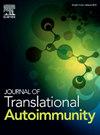强直性脊柱炎的综合质谱驱动的多组学和单细胞技术:发病机制、生物标志物发现和精准医学的见解
IF 3.6
Q2 IMMUNOLOGY
引用次数: 0
摘要
强直性脊柱炎(AS)是一种主要影响中轴骨骼的慢性炎症性关节炎,由于其复杂的发病机制、延迟的诊断和异质性的治疗反应,给临床带来了重大挑战。本文综述了基于质谱(MS)的多组学技术在阐明AS发病机制、识别疾病特异性生物标志物和推进AS精准医学方面的关键作用。概述了质谱的基本原理,包括电离方法,如电喷雾和基质辅助激光解吸/电离,质量分析仪,如轨道阱和飞行时间,分离系统,包括液相和气相色谱。这些技术能够对蛋白质组、代谢组和脂质组进行高度敏感和全面的分析。蛋白质组学分析揭示了失调的途径,并确定了关键的生物标志物,包括补体成分、基质金属蛋白酶和“c反应蛋白+血清淀粉样蛋白A1”面板,用于区分活性AS与健康对照和稳定AS。代谢组学研究强调色氨酸-犬尿氨酸代谢和肠道微生物衍生代谢物(包括短链脂肪酸)的紊乱,从而将微生物失衡与炎症反应联系起来。三种代谢物(3-氨基-2-哌啶酮、次黄嘌呤和十八胺)的组合有望作为as诊断的血清生物标志物。脂质组学分析揭示了磷脂组成的显著变化。此外,新兴的单细胞技术(如大量细胞术)已经解剖了AS的免疫异质性,揭示了单核细胞和t细胞亚群中的趋化因子信号失调。讨论了持续的挑战和未来的进展,如数据异质性、队列限制和多组学集成人工智能模型的可解释性。通过将技术创新与临床见解相结合,本综述系统地总结了多个潜在的AS生物标志物面板,其中多组学驱动策略促进了AS的早期诊断,机制亚型和个性化治疗,最终改善了AS患者的预后。本文章由计算机程序翻译,如有差异,请以英文原文为准。
Integrative mass spectrometry-driven multi-omics and single cell technologies in ankylosing spondylitis: insights into pathogenesis, biomarker discovery, and precision medicine
Ankylosing spondylitis (AS), a chronic inflammatory arthritis primarily affecting the axial skeleton, presents significant clinical challenges due to its complex pathogenesis, delayed diagnosis, and heterogeneous therapeutic responses. This review highlights the pivotal role of mass spectrometry (MS)-based multi-omics technologies in elucidating AS pathogenesis, identifying disease-specific biomarkers, and advancing precision medicine for AS. The fundamental principles of MS are outlined, encompassing ionization methods like electrospray and matrix-assisted laser desorption/ionization, mass analyzers such as orbitrap and time-of-flight, and separation systems including liquid and gas chromatography. These technologies enable highly sensitive and comprehensive profiling of proteomes, metabolomes, and lipidomes. Proteomics analyses have revealed dysregulated pathways and identified key biomarkers, including complement components, matrix metalloproteinases and the panel “C-reactive protein + serum amyloid A1”, for distinguishing active AS from healthy controls and stable AS. Metabolomics studies emphasize disturbances in tryptophan-kynurenine metabolism and gut microbiome-derived metabolites, including short-chain fatty acids, thereby linking microbial imbalance to inflammatory responses. A combination of three metabolites (3-amino-2-piperidone, hypoxanthine, and octadecylamine) has shown promise as serum biomarkers for AS diagnosis. Lipidomics profiling reveals significant changes in phospholipid composition. Furthermore, emerging single cell technologies (e.g., mass cytometry) have dissected immune heterogeneity in AS, revealing chemokine signaling dysregulation in monocyte and T-cell subclusters. Persistent challenges and future advancements, such as data heterogeneity, cohort limitations, and the interpretability of artificial intelligence models for multi-omics integration were discussed. By integrating technological innovation with clinical insights, this review systematically summarizes multiple potential biomarker panels for AS, in which multi-omics-driven strategies facilitate early diagnosis, mechanistic subtyping, and personalized therapies, ultimately improving patient outcomes in AS.
求助全文
通过发布文献求助,成功后即可免费获取论文全文。
去求助
来源期刊

Journal of Translational Autoimmunity
Medicine-Immunology and Allergy
CiteScore
7.80
自引率
2.60%
发文量
33
审稿时长
55 days
 求助内容:
求助内容: 应助结果提醒方式:
应助结果提醒方式:


